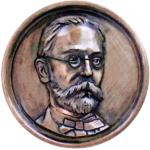W opracowaniu
Aktualny numer
Numery specjalne
Archiwum
O czasopiśmie
Redakcja
Rada Redakcyjna
Recenzenci
Instrukcja redakcyjna
Zasady etyki publikacyjnej
Zasady recenzowania
Ghostwriting
Prawa autorskie i polityka Open Access
Klauzula informacyjna RODO – dla autorów artykułów zgłoszonych do publikacji w kwartalniku „Komunikaty Mazursko-Warmińskie”
Kontakt
Cennik
PROJEKTY
Biskupa Wydżgi troska o warmińskie sprawy
1
Ośrodek Badań Naukowych im. Wojciecha Kętrzyńskiego w Olsztynie
Data publikacji online: 02-08-2016
Data publikacji: 02-08-2016
KMW 2016;292(2):303-331
SŁOWA KLUCZOWE
DZIEDZINY
STRESZCZENIE
Bishop Jan Stefan Wydżga was in the government of Warmia during the Polish-Swedish War. Following
the end of the war, there was no peace for the episcopal domain. The bishop’s concern was to free Frombork and
Braniewo from the Brandenburgian occupation. He managed to free Frombork from the elector’s armies relatively
quickly, whilst Braniewo was only left by Brandenburgian forces in October 1663. However, the threat from Brandenburg remained. When the Brandenburgian contingent was on its way to Ukraine, Warmia provided fodder and
food, and when it returned it passed through the domain or nearby, the inhabitants again had to provision it. The bishop became alaramed in 1678, when a Swedish invasion of Royal Prussia. It seemed that the war would also
affect the domain of Warmia. There was fear. Bishop Wydżga was constantly concerned about the taxation of the
Polish troops. Taxes were passed by the Parliamentary General of Royal Prussia, the bishops in the Sejms agreed
to the extraordinary taxes, and finally the priesthood had to provide a hyberne. Wydżgaand the canons did not
object to the taxes, the hybernas brought in money which saved Warmia from the stopover of the crown’s armies.
In the bishop’s correspondence tax issues occupy a substantial amount of space – to pay or delay with payment.
Wydżga even brought in prepayments before the relevant tax resolutions were passed, he was afraid of the unpunished soldiers. The internal affairs of Warmia caused him a lot of trouble but he was able to deal with the problems
extremely well. The bishop complained he had to financially support the manor, the poor, to repair the churches
and to rebuild the Warmia after the destruction of the Polish-Swedish War. However, in his correspondence there
is no mention of building a baroque mansion; at most repairing the buildings in the forecourt. It can therefore be
concluded that the construction of the baroque palace on the southern side of the castle cannot be attributed to
him. At most, Wydżga repaired the buildings constructed by Bishop Maurice Ferber.
Udostępnij
ARTYKUŁ POWIĄZANY
Przetwarzamy dane osobowe zbierane podczas odwiedzania serwisu. Realizacja funkcji pozyskiwania informacji o użytkownikach i ich zachowaniu odbywa się poprzez dobrowolnie wprowadzone w formularzach informacje oraz zapisywanie w urządzeniach końcowych plików cookies (tzw. ciasteczka). Dane, w tym pliki cookies, wykorzystywane są w celu realizacji usług, zapewnienia wygodnego korzystania ze strony oraz w celu monitorowania ruchu zgodnie z Polityką prywatności. Dane są także zbierane i przetwarzane przez narzędzie Google Analytics (więcej).
Możesz zmienić ustawienia cookies w swojej przeglądarce. Ograniczenie stosowania plików cookies w konfiguracji przeglądarki może wpłynąć na niektóre funkcjonalności dostępne na stronie.
Możesz zmienić ustawienia cookies w swojej przeglądarce. Ograniczenie stosowania plików cookies w konfiguracji przeglądarki może wpłynąć na niektóre funkcjonalności dostępne na stronie.




